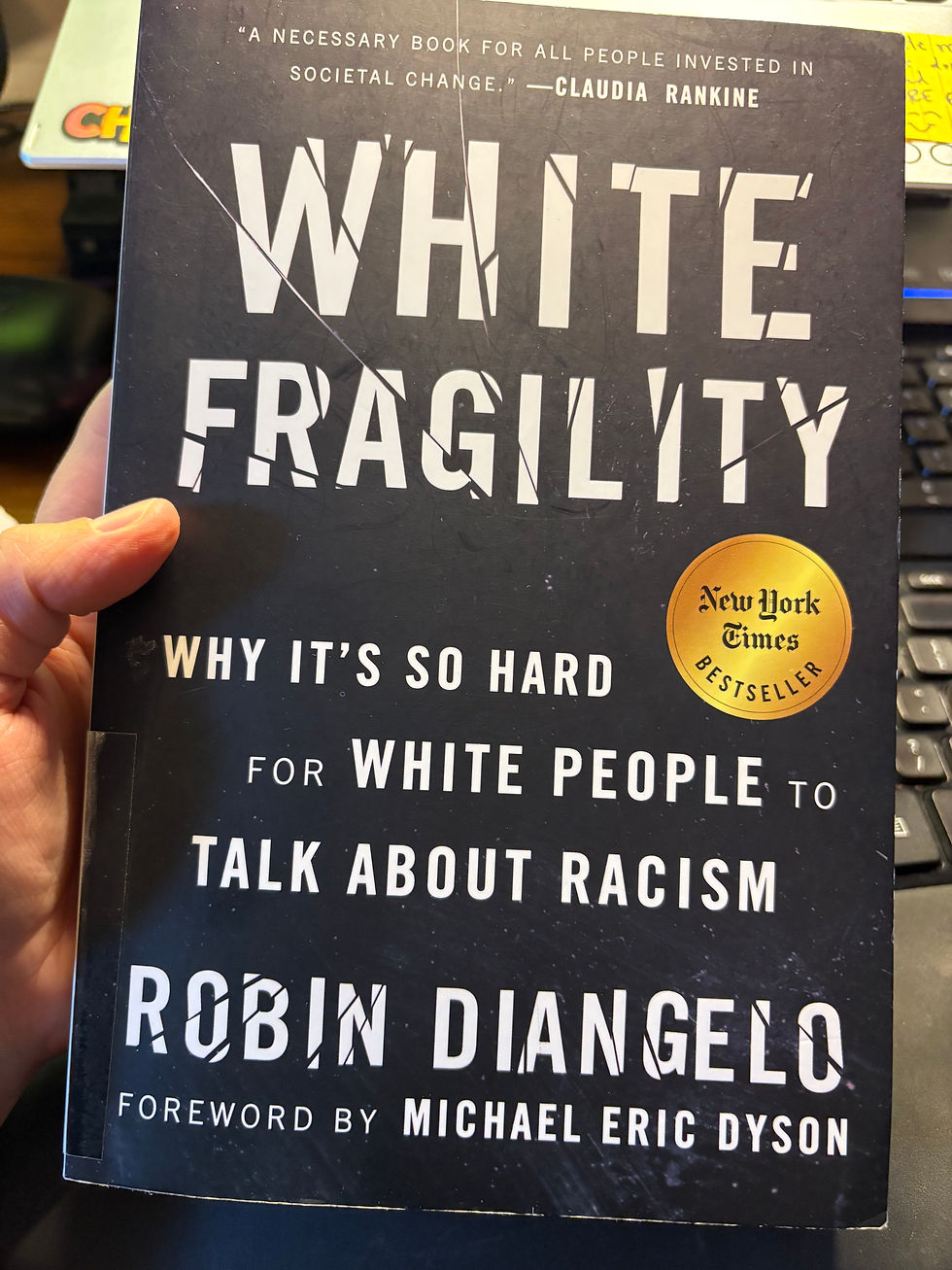My key takeaways from the book White Fragility by Robin Diangelo
- Chelsea Bradley

- Oct 5
- 4 min read
The notes before the notes:
These are my notes exactly as I wrote them in my notepad while reading White Fragility by Robin Diangelo. Anything that is NOT by Robin Diangelo or is of my own personal thoughts are denoted by "NTS:" Note to self.
Secondly - any person that is white or mostly white, should read this book. And when you do, open your mind and your heart!

WHITE FRAGILITY
TRAIN2BCLUTCH Reading Challenge
Notes and Takeaways
WHITE FRAGILITY
Intro -
We don’t have to intend to exclude for the results of our actions to be exclusion.
Inequity can occur simply through homogeneity; if I’m not aware of the barriers you face, then I won’t see them, much less be motivated to remove them.
If I understand racism as a system to which I was socialized, I can receive feedback on my problematic racial patterns as a helpful way to support my learning and growth.
The author defines white progressives as white people who think they are not racist, or in the “choir,” or already “gets it.”
White progressives can be the most difficult for people of color because, to the degree that we think we have arrived, we will put our energy into making sure others see us as having arrived.
We cannot understand modern forms of racism if we cannot, or will not, explore patterns of group behavior & their effects on individuals
Ch.2 Racism & White Supremacy
“It is on each of us who pass as white to identify how these advantages shape us, not to deny them whole scale.”
“Poor & working class whites were eventually granted full entry into whiteness as a way to exploit labor. If poor whites were focused on feeling superior to those below them in status, they were less focused on the above. The poor & working classes, if united across race, could be a powerful force. But racial divisions have served to keep them from organizing against the owning class who profits from their labor.”
White supremacy is more than an idea that whites are superior to people of color; it is a deeper premise that supports this idea - the definition of whites as the norm or standard for human, and people of color as a deviation from that norm.
White supremacy makes the system visible & shifts the locus of change onto white people, where it belongs.
This does not mean that people of color do not play a part but that the full weight of responsibility (for change in racism) rests with those who control institutions (90% or greater white)
Upward mobility is the great class goal in the United States & the social environment get tangibly whiter the higher up you climb. Whiter environments in turn, are seen as the most desirable.
NTS: If we find something of value, we will take effort to have that in our lives.
Look around…reflect on spaces you have been. Dentist/doctor/school/work/grocery/shopping - mostly white people and white areas!
History matters.
Ch.5 The Good/Bad Binary
Quote on p.72 “Racism is a systemic, societal, institutional, omnipresent and epistemologically embedded phenomenon that parades every vestige of our reality. For most whites, however, racism is like murder: the concept exists, but someone has to commit it in order for it to happen. This limited view of such a multilayered syndrome cultivates the sinister nature of racism and, in fact, perpetuates racist phenomena rather than eradicates them.”
“If, as a white person, I conceptualize racism as a binary and I place myself on the “not racist” side, what further action is required of me? No action is required, because I am not a racist. Therefore, racism is not my problem; it doesn’t concern me and there is nothing further I need to do. This worldview guarantees that I will not build my skills in thinking critically about racism or use my position to challenge racial inequality.”
Ch. 6 Anti-Blackness
The trigger for white rage, inevitably, is black advancement.
Ch.7 Racial Triggers for White People
When disequilibrium occurs - when there is an interruption to that which is familiar and taken for granted - white fragility restores equilibrium & returns capital “lost” via the challenge.
(When whites are challenged w/ having perpetuated race)
Ch. 8 The Result: White Fragility
If whites cannot explore alternate racial perspectives, they can only reinscribe white perspectives as universal.
“The continual retreat from the discomfort of authentic racial engagement in a culture in which racial disparity is infused, limites white people’s ability to form authentic connections across racial lines & perpetuates a cycle that keeps racism in place” 🙁
Ch. 9 White Fragility & the Rules of Engagement
As white people, stopping our racist patterns must be more important than working to convince others that we don’t have them.
We do have them & people of color already know we have them.
Ch. 10 White Women’s Tears
Emotions are political. Our emotions are shaped by our biases & beliefs, our cultural frameworks.
Men vs. women expressing anger example
Our racist socialization sets us up to repeat racist behaviors, regardless of our intentions or self-image. We must continue to ask how our racism manifests, not if.
Last chapter
NTS: Get involved w/ multiracial organizations and white organizations working for racial justice.
.png)



Comments